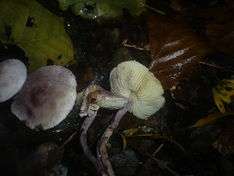Cystolepiota bucknallii
Cystolepiota bucknallii is a species of basidiomycete fungus of the genus Cystolepiota. Found throughout Europe, it is a rare fungus occurring in deciduous forests. The small fruit bodies bear a distinctive smell of coal gas and appear in autumn on damp ground. It is not an edible mushroom.
| Cystolepiota bucknallii | |
|---|---|
 | |
| Scientific classification | |
| Kingdom: | |
| Division: | |
| Class: | |
| Order: | |
| Family: | |
| Genus: | |
| Species: | C. bucknallii |
| Binomial name | |
| Cystolepiota bucknallii | |
| Synonyms[1] | |
| Cystolepiota bucknallii | |
|---|---|
float | |
| gills on hymenium | |
| cap is convex | |
| hymenium is free | |
| stipe is bare | |
| spore print is white | |
| ecology is saprotrophic | |
| edibility: inedible | |
Description
The fruit body of Cystolepiota bucknallii is a relatively small, thin-fleshed agaric. The cap is at first hemispherical and becomes convex with maturity. It bears a broad central umbo and reaches 5 cm in diameter. The cap cuticle is white with a lilac or violet tinge. The gills are crowded and not attached to the stipe. Their colour is cream to pale yellow. The stipe is comparatively long (up to 6 cm), slender and bare, tinged lilac or violet except for the uppermost section where it is pallid. Both cap and stipe are covered with a mealy powder which is easily rubbed off. All parts are fragile. The flesh is white, thin and does not bear a distinctive taste.[2][3]
The spore mass is white. With the aid of a light microscope, the spores are seen ellipsoid, smooth and colourless. When Melzer's reagent is applied, the spore walls barely stain; hence, the spores are weakly dextrinoid. Their dimensions are 7.5–10 µm by 1–3.5 µm.[2][3]
Cystolepiota bucknallii has a characteristically pungent odour, reminiscent of coal gas or sulphur. Indole is present in this as well as in other similar-scented fungi: Tricholoma inamoenum, Tricholoma lascivum, Tricholoma sulphureum and others.[4]
While its edibility is not known, there exists speculation about possible toxicity.[2][3]
Habitat
C. bucknallii has been recorded in various countries in central and northern Europe including France, Belgium, Switzerland, Austria, Germany, Denmark, Norway, Sweden and Russia.[5] It is a terrestrial decomposer which occurs in deciduous forests with moist, calcareous soils rich in nutrients and especially nitrogen. Fruit bodies appear in autumn.[3] Moreover, C. bucknallii is an uncommon or rare fungus whose populations are found in communities harbouring a diversity of other rare species. A population may serve as an indicator for rich, conservable biotopes.[6]
References
- "GSD Species Synonymy:Cystolepiota bucknallii (Berk. & Broome) Singer & Clémençon". Species Fungorum. CAB International. Retrieved 2014-11-16.
- "Cystolepiota bucknallii at Rogers Mushrooms". Rogers Plants Ltd. Archived from the original on July 8, 2008. Retrieved December 13, 2009.
- Jordan M. (1995). The Encyclopedia of Fungi of Britain and Europe. London: David & Charles. p. 215. ISBN 0-7153-0129-2.
- Wood W.; Smith J.; Wayman K.; Largent D. (2003). "Indole and 3-chloroindole: The source of the disagreeable odor of Hygrophorus paupertinus". Mycologia. 95 (5): 807–08. doi:10.2307/3762008. JSTOR 3762008.
- "Cystolepiota bucknallii - GBIF Portal". GBIF. Retrieved 2 February 2010.
- "Factsheet: Cystolepiota bucknallii – violettfotad puderskivling" (PDF) (in Swedish). ArtDatabanken.